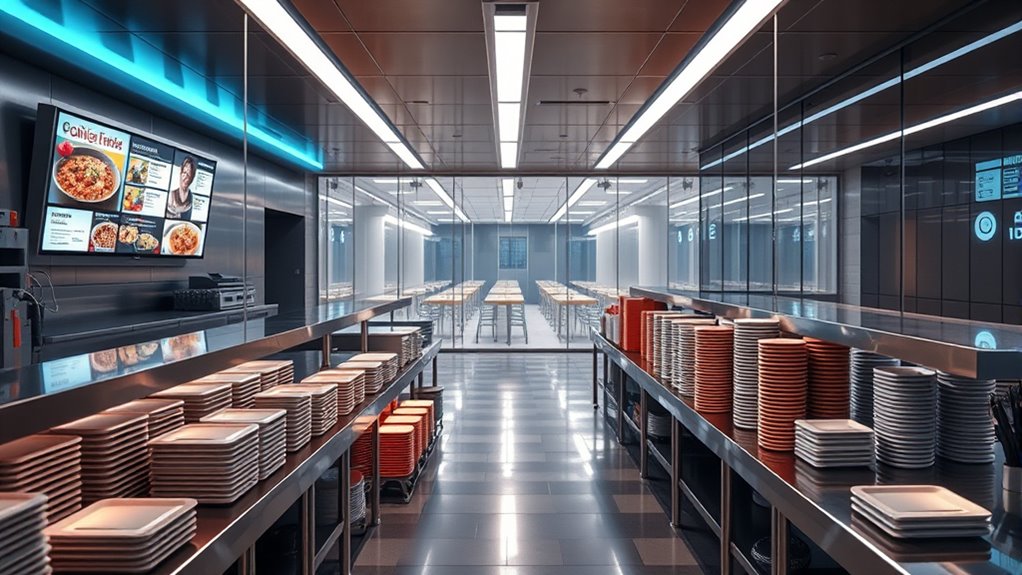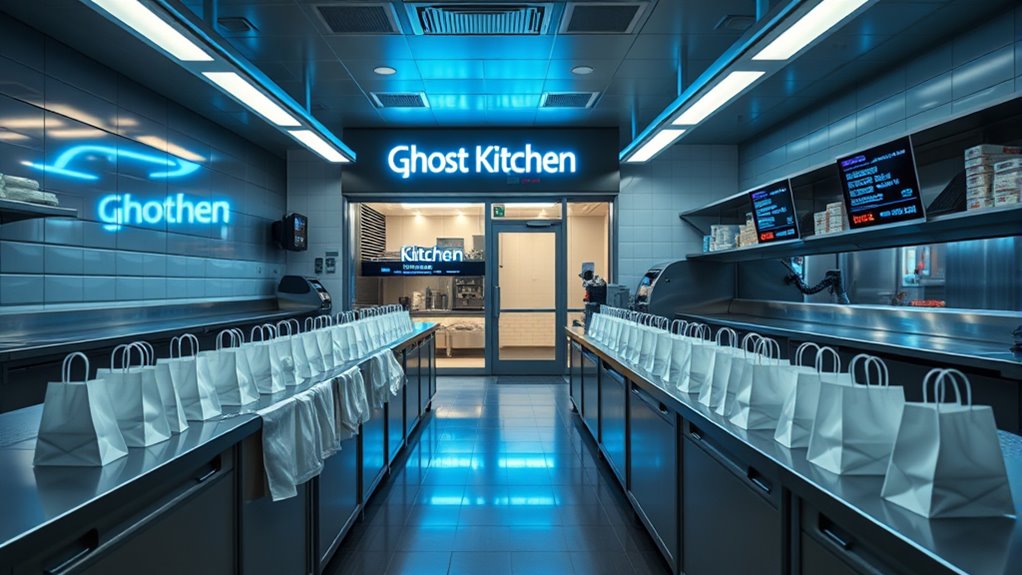A ghost kitchen is a delivery-only restaurant that doesn’t have a physical dining space. It operates solely through online orders on apps like Uber Eats or DoorDash, focusing on food preparation for delivery. This model lets you enjoy a variety of cuisines without visiting a traditional restaurant. Ghost kitchens help restaurants expand quickly, offering new options and faster service. Discover more about how this innovative approach is changing the way we enjoy food.
Key Takeaways
- A ghost kitchen is a restaurant that operates solely for delivery, without a physical dining space.
- It prepares food exclusively for online orders via delivery apps like Uber Eats or DoorDash.
- Ghost kitchens enable restaurants to expand reach and launch multiple brands from one location.
- They focus on efficiency, quick order processing, and maintaining high-quality food for delivery.
- Virtual branding allows targeted marketing and customer segmentation without a traditional storefront.

Have you ever wondered how your favorite takeout arrives so quickly without a traditional restaurant front? The answer lies in the rise of ghost kitchens, a new way for restaurants to operate and serve customers. Unlike conventional restaurants with dining spaces and storefronts, ghost kitchens are solely focused on restaurant delivery. They exist only in the digital domain, with no physical dining area for customers to visit. Instead, these kitchens prepare food specifically for online orders placed through delivery apps and platforms. This setup allows restaurants to expand their reach without the hefty costs of maintaining a brick-and-mortar location.
Ghost kitchens focus solely on delivery, operating without physical dining spaces or storefronts.
One of the key advantages of ghost kitchens is the ability to optimize restaurant delivery services. Since these kitchens are designed for efficiency, they streamline order preparation and dispatch, reducing wait times and improving delivery speed. This ensures you get your meal fresh and hot, even if you’re miles away from the kitchen. For restaurant owners, ghost kitchens also open up new revenue streams without the financial burden of a traditional restaurant. They can operate multiple brands from a single location, tailoring menus to different customer preferences or cuisines—all under one roof. This flexibility makes it easier to experiment with new concepts and expand quickly into new markets.
Virtual branding plays a significant role in the success of ghost kitchens. By creating distinct digital identities for each brand, restaurants can target specific customer segments and stand out in a crowded delivery marketplace. For example, a ghost kitchen might run a pizza brand, a vegan burger brand, and a dessert brand all from one facility. Each brand has its own online presence, marketing strategies, and menu, allowing for precise targeting and branding that resonates with different audiences. You might see one menu on Uber Eats and a different one on DoorDash, all managed seamlessly from the same kitchen. This approach helps restaurants grow their customer base and build loyalty through tailored marketing and branding efforts.
In essence, ghost kitchens leverage virtual branding to maximize reach and visibility in the digital space. They focus entirely on optimizing the restaurant delivery experience, ensuring that your food arrives quickly, hot, and exactly how you ordered it. Additionally, incorporating automotive repair principles like efficient workflows and streamlined processes can help ghost kitchens improve their operations further. This model reflects the changing landscape of food service, emphasizing convenience and digital marketing over traditional dine-in experiences. So, next time you place an order and wonder how your meal gets to you so fast, you’ll know it’s likely coming from a ghost kitchen—an innovative, efficient way for restaurants to serve you better through virtual branding and streamlined delivery.
Frequently Asked Questions
How Do Ghost Kitchens Differ From Traditional Restaurants?
You’ll find ghost kitchens differ from traditional restaurants because they focus solely on delivery and takeout, streamlining delivery logistics. Without a dine-in space, they often emphasize menu innovation, testing new concepts quickly and efficiently. You won’t see sit-down service here, but they leverage technology to optimize order processing. This allows them to adapt rapidly, reduce costs, and serve a wider audience without the overhead of a traditional brick-and-mortar restaurant.
Are Ghost Kitchens More Environmentally Sustainable?
Yes, ghost kitchens tend to be more environmentally sustainable because they use energy more efficiently and often employ sustainable packaging. Since they operate without dine-in spaces, there’s less waste and reduced energy consumption. You can support their eco-friendly efforts by choosing places that prioritize sustainable packaging and energy-efficient appliances. This way, you help minimize your environmental impact while enjoying convenient meals.
What Are the Startup Costs for Opening a Ghost Kitchen?
You’ll need around $100,000 to $300,000 to start a ghost kitchen, covering equipment, permits, and initial inventory. Focus on menu customization to attract different customers, and plan your delivery logistics carefully to guarantee quick service. Costs vary depending on location and scale, so consider leasing or renting kitchen space, investing in marketing, and setting aside funds for staff. Proper planning helps you manage expenses and grow your ghost kitchen effectively.
Can Ghost Kitchens Operate Internationally?
Yes, ghost kitchens can operate internationally, but you need to take into account international expansion carefully. You’ll have to navigate cross border regulations, including import/export laws, food safety standards, and local licensing requirements. Establishing partnerships or local entities can help you manage these complexities. Planning for different markets’ tastes and delivery logistics is also essential. With thorough research and compliance, you can successfully expand your ghost kitchen operations across borders.
How Do Ghost Kitchens Ensure Food Safety Standards?
Like a vigilant lighthouse guiding ships safely, ghost kitchens prioritize food safety by strictly adhering to hygiene practices and regulations. You guarantee proper storage, maintain cleanliness, and monitor temperature controls consistently. Staff training emphasizes sanitation, and regular inspections help prevent contamination. By implementing these measures, you create a safe environment where food safety is at the forefront, safeguarding customer health and building trust in your virtual culinary venture.
Conclusion
Now that you know what a ghost kitchen is, you might wonder how it’s changing the way you enjoy food. With no dine-in options and a focus on delivery, these kitchens offer convenience like never before. But as more pop up, ask yourself: are we sacrificing the experience of eating out for quick meals? Ultimately, ghost kitchens are reshaping dining—are you ready to embrace this new era of food?









